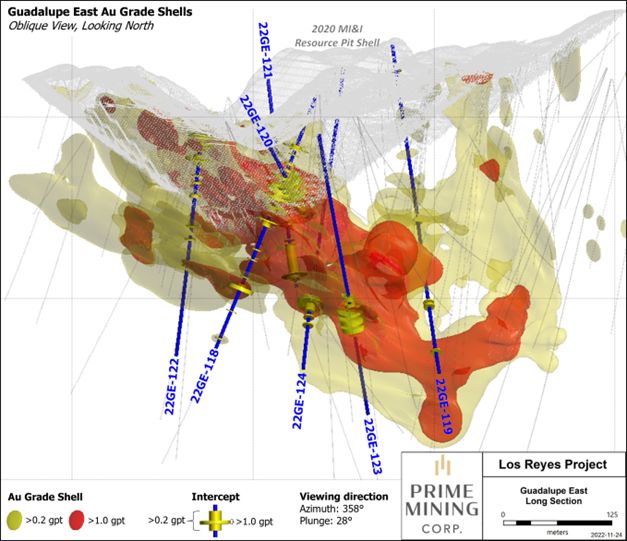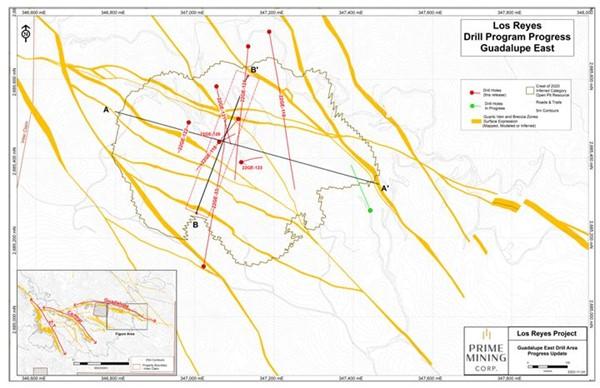
Prime Drills Multiple Bonanza and High-Grade Intercepts at Guadalupe Including 33.2 gpt Au and 1,072 gpt Ag over 2.0 Metres
Prime Mining Corp. (TSX-V: PRYM) (OTCQB: PRMNF) (Frankfurt: 04V3) announces additional assay results from its recently completed Phase 2 drill program. Today’s results are from the Guadalupe area where Prime continues to delineate and expand the multi-million-ounce Los Reyes high-grade gold-silver deposit. Los Reyes and its three known gold-silver deposit areas (Guadalupe, Z-T and Central), has a mineralized footprint of over 15 square kilometres and is located in a highly prospective, 500-year old mining-friendly district of Sinaloa, Mexico.
Today’s results are from seven drill holes in the main Guadalupe deposit.
HIGHLIGHT GUADALUPE DRILL INTERCEPTS:
- 6.8 gpt Au and 166 gpt Ag over 19.5 m (18.3 m estimated true width or “etw”) in hole 22GE-118
- 12.8 gpt Au and 646 gpt Ag over 3.3 m (1.1 m etw), and 4.2 gpt Au and 212 gpt Ag over 37.2 m (12.7 m etw) in hole 22GE-121
- 8.8 gpt Au and 289 gpt Ag over 7.9 m (5.6 m etw), including 33.2 gpt Au and 1,072 gpt Ag over 2.0 m (1.4 m etw) in drill hole 22GE-122
- 6.8 gpt Au and 208 gpt Ag over 13.6 m (6.8 m etw) in hole 22GE-120
Drilling continues to encounter bonanza and high-grade intercepts at Guadalupe with additional remarkable gold and silver values being intercepted in the Estaca Vein. Additionally, outside of the main Estaca Vein, drilling is delineating a cluster of mineralized vein splays within the main Guadalupe deposit. It is anticipated that these results will further expand resources at Guadalupe.
Chief Executive Officer, Daniel Kunz commented, “We are very excited about the progress we have made in the Phase 2 drill program. Our exploration team has improved the structural modelling demonstrably, which has resulted in a more targeted and accurate drill program. As a result, the number of wide, high-grade intercepts we are seeing in our results has increased. Our recent drilling, specifically at Guadalupe East, has intersected multiple thick, high-grade gold and silver veins. These new veins are increasing the high-grade zones both within and outside of the known mineralized envelope. We will continue to target these high-grade structures as they remain open along strike and at depth. As we work towards delivering a resource estimate in the first half of next year, we are excited about the increasing contribution of these bonanza grade veins at Los Reyes.”
Scott Smith, EVP Exploration added: “Drill holes 22GE-118, 120, and 122 intersected impressive Estaca Vein Splays. Continued drilling success in these vein assemblages will add high-grade ore tonnes and reduce pit waste-to-ore ratios at Guadalupe. Holes 22GE-121, 123 and 124 intersected the main Estaca Vein itself approximately 150 m further along strike and down dip of the April 2020 resource pit limit. Hole 22GE-120 also went on to intercept the Estaca Vein after passing through the splays.”
Today’s results highlight recent success in expanding the Guadalupe deposit and are shown in the Significant Intercepts Table below.
Phase 2 drilling was completed on October 31. In total, 74,216 metres were drilled in 259 holes with zero lost-time injuries or material safety incidents. Combined with Phase 1 and on-going drilling, Prime has now drilled over 100,000 metres in over 400 holes. Further details of the Phase 2 drilling results will be released as they become available.
Phase 3 drilling began in November. There are currently five rigs operating at site with drilling focused largely on resource expansion. Prime currently anticipates the release of an updated NI 43-101 resource estimate by mid-2023. The updated resource will include all Phase 1 and Phase 2 results, plus some initial results from the ongoing Phase 3 drilling program.
Figure 1: Guadalupe East Grade Shell Longitudinal Section
SIGNIFICANT INTERCEPTS TABLE FROM RECENT DRILLING AT GUADALUPE:
| Drill Hole | From (m) | To (m) | Length (m) | ETW (m) | Au (g/t) | Ag (g/t) | Vein |
| 22GE-118 | 56.0 | 62.4 | 6.4 | 5.5 | 3.0 | 215 | Estaca Splays |
| including | 59.2 | 60.3 | 1.1 | 1.0 | 6.8 | 469 | Estaca Splays |
| 22GE-118 | 102.0 | 121.5 | 19.5 | 18.3 | 6.8 | 166 | Estaca Splays |
| including | 103.4 | 113.1 | 9.7 | 9.1 | 11.6 | 262 | Estaca Splays |
| & including | 117.0 | 120.0 | 3.0 | 2.8 | 4.8 | 144 | Estaca Splays |
| 22GE-118 | 128.0 | 135.5 | 7.5 | 7.2 | 2.9 | 89 | Estaca Splays |
| including | 128.0 | 129.5 | 1.5 | 1.4 | 9.9 | 231 | Estaca Splays |
| 22GE-118 | 144.5 | 152.0 | 7.5 | 7.2 | 2.9 | 101 | Estaca Splays |
| including | 144.5 | 146.0 | 1.5 | 1.4 | 7.0 | 327 | Estaca Splays |
| 22GE-118 | 221.0 | 228.5 | 7.5 | 7.4 | 2.0 | 72 | Estaca Splays |
| including | 224.0 | 228.5 | 4.5 | 4.4 | 2.8 | 90 | Estaca Splays |
| 22GE-119 | 351.4 | 354.0 | 2.6 | 1.8 | 1.0 | 81 | Estaca |
| 22GE-120 | 44.5 | 58.1 | 13.6 | 6.8 | 6.8 | 207 | Estaca Splays |
| including | 47.5 | 50.5 | 3.0 | 1.5 | 12.2 | 537 | Estaca Splays |
| & including | 55.1 | 56.8 | 1.7 | 0.9 | 23.0 | 495 | Estaca Splays |
| 22GE-120 | 61.0 | 74.5 | 13.5 | 6.7 | 3.5 | 75 | Estaca Splays |
| including | 64.0 | 65.5 | 1.5 | 0.8 | 11.3 | 245 | Estaca Splays |
| & including | 68.5 | 70.0 | 1.5 | 0.8 | 9.9 | 149 | Estaca Splays |
| 22GE-121 | 163.5 | 166.8 | 3.3 | 1.1 | 12.8 | 646 | Estaca Splays |
| 22GE-121 | 189.0 | 226.2 | 37.2 | 12.7 | 4.2 | 212 | Estaca |
| including | 193.5 | 195.0 | 1.5 | 0.5 | 10.2 | 547 | Estaca |
| & including | 218.5 | 219.8 | 1.3 | 0.4 | 10.9 | 765 | Estaca |
| & including | 222.0 | 223.0 | 1.0 | 0.3 | 21.0 | 413 | Estaca |
| 22GE-122 | 0.0 | 19.5 | 19.5 | 13.8 | 2.2 | 54 | Estaca Splays |
| including | 15.0 | 16.5 | 1.5 | 1.1 | 9.1 | 141 | Estaca Splays |
| 22GE-122 | 26.2 | 34.1 | 7.9 | 5.6 | 8.8 | 289 | Estaca Splays |
| including | 30.3 | 32.3 | 2.0 | 1.4 | 33.2 | 1072 | Estaca Splays |
| 22GE-123 | 223.5 | 230.0 | 6.5 | 2.7 | 4.5 | pending | Estaca |
| including | 225.1 | 228.0 | 2.9 | 1.2 | 9.2 | pending | Estaca |
| 22GE-123 | 232.0 | 250.5 | 18.5 | 7.8 | 2.2 | pending | Estaca |
| 22GE-124 | 298.0 | 300.4 | 2.4 | 2.3 | 6.9 | pending | Estaca |
| 22GE-124 | 324.0 | 325.3 | 1.3 | 1.3 | 2.6 | pending | Estaca Splays |
Link 1 – PDF Figures
Link 2 – PDF Drill Hole Tables
Guadalupe Drilling Results and Interpretation
In addition to the significant intercepts shown above, Prime has released the full current assay table for the Guadalupe area (Link 2 above). While some of the holes included in that table are more exploratory in nature, holes targeting the key mineralized vein structures in Guadalupe continue to indicate potential high-grade, high-margin resource expanding ounces characteristic of the Guadalupe area. Included in these results are intersections of various structures, including previous underground workings. Where previous workings or stopes have encountered what has been interpreted as backfill material, these segments have been included in the table and identified as such in the ‘Vein’ column and will be excluded from future reported resource inventories and will not influence interpolated resource block grades. Highlights and significant intercepts shown above only include what has been interpreted as in situ material, and do not include any assayed backfill material. “Pending” silver grades in the Significant Intercepts table above indicate that part of the composites may have assayed over 100 gpt and follow-up ‘over-limit’ test results have not been received.
QA/QC Protocols and Sampling Procedures
Drill core at the Los Reyes project is drilled in predominately HQ size (63.5 millimetre “mm”), reducing to NQ or BQ size ranges (47.6 mm and 36.5 mm respectively) when required. Drill core samples are generally 1.50 m long along the core axis with allowance for shorter or longer intervals if required to suit geological constraints. After logging intervals are identified to be sampled and split, and one half is submitted for assay. RC drilling returns rock chips and fines from a 133.35 mm diameter tricone bit. The returns are homogenized and split into 2 halves, with one half submitted for analysis and the other half stored.
Sample QA/QC measures include unmarked certified reference materials, blanks, and field duplicates as well as preparation duplicates are inserted into the sample sequence and make up approximately 8% of the samples submitted to the laboratory for each drill hole.
Samples are picked up from the Project by the laboratory personnel and transported to their facilities in Durango or Hermosillo Mexico, for sample preparation. Sample analysis is carried out by Bureau Veritas and ALS Labs, with fire assay, including over limits fire assay re-analysis, completed at their respective Hermosillo, Mexico laboratories and multi-element analysis completed in North Vancouver, Canada. Drill core sample preparation includes fine crushing of the sample to at least 70% passing less than 2 mm, sample splitting using a riffle splitter, and pulverizing a 250-gram split to at least 85% passing 75 microns.
Gold in diamond drill core is analyzed by fire assay and atomic absorption spectroscopy of a 30 g sample (code FA430 or Au-AA23). Multi-element chemistry is analyzed by 4-Acid digestion of a 0.25-gram sample split (code MA300 or ME-ICP61) with detection by inductively coupled plasma emission spectrometer for a full suite of elements.
Gold assay techniques FA430 and Au-AA23 have an upper detection limit of 10 ppm. Any sample that produces an over-limit gold value via the initial assay technique is sent for gravimetric finish via method FA-530 or Au-GRA21. Silver analyses by MA300 and ME-ICP61 have an upper limit of 200 ppm and 100 ppm, respectively. Samples with over-limit silver values are re-analyzed by fire assay with gravimetric finish FA530 or Au-GRA21.
Both Bureau Veritas and ALS Labs are ISO/IEC accredited assay laboratories. Drill core assay results range from below detection to 200.0 gpt gold and 4,955.0 gpt silver.
Qualified Person
Scott Smith, P.Geo., Executive Vice President of Exploration, is a qualified person for the purposes of National Instrument 43-101 and has reviewed and approved the technical content in this news release.
Additional Notes
Metres is represented by “m”; “etw” is Estimated True Width and is based on drill hole geology or comparisons with other on-section drill holes; “Au” refers to gold, and “Ag” refers to silver; “gpt” is grams per metric tonne; some figures may not sum due to rounding; Composite assay grades presented in summary tables are calculated using a Au grade minimum average of 0.20 gpt or 1.0 gpt as indicated in “Au Cut-off” column of Summary Tables. Maximum internal waste included in any reported composite interval is 3.00 m. The 1.00 gpt Au cut-off is used to define higher-grade “cores” within the lower-grade halo.
About the Los Reyes Gold and Silver Project
Los Reyes is a rapidly evolving high-grade, low sulphidation epithermal gold-silver project located in Sinaloa State, Mexico. Historic operating results indicate that an estimated 1 million ounces of gold and 60 million ounces of silver were recovered from five separate operations at Los Reyes between 1770 and 1990. Prior to Prime’s acquisition, recent operators of Los Reyes had spent approximately US$20 million on exploration, engineering, and prefeasibility studies. The Project remains underexplored and holds potential for additional discovery and resource expansion.
Since acquiring Los Reyes in 2019, Prime has spent approximately US$30 million on direct exploration activities and has completed two phases of comprehensive drilling totaling over 100,000 m. Results to date suggest the three known main deposit areas, Guadalupe, Central and Z-T, are larger than previously reported. Potential also exists for new discoveries outside of the currently defined resource areas.
About Prime Mining
Prime is managed by an ideal mix of successful mining executives, strong capital markets personnel and experienced local operators all focused on unlocking the full potential of the Los Reyes Project. The Company has a well-planned capital structure with a strong management team and insider ownership.
Figure 2
Figure 3
Figure 4
MORE or "UNCATEGORIZED"
Quimbaya Gold Closes $4 Million Financing and Expands Executive Team
Cornerstone investor brings proven regional track record; company... READ MORE
Spanish Mountain Gold Announces Larger Scale Preliminary Economic Assessment With a Base Case NPV5% After-Tax of C$1.0 Billion, 18.2 % IRR and 3.4 Year Payback at US$ 2,450/Oz Gold Price; at US$3,300/Oz Spot Gold Price NPV5% C$2.3 Billion, 32.0% IRR and 2.0 Year Payback; Including an Updated Mineral Resource Estimate for Its Spanish Mountain Gold Project
Spanish Mountain Gold Ltd. (TSX-V: SPA) (FSE: S3Y) (OTCQB: SPAUF)... READ MORE
Aura Announces Preliminary Q2 2025 Production Results
Aura Minerals Inc. (TSX: ORA) (B3: AURA33) (OTCQX: ORAAF) is plea... READ MORE
Cascadia Announces Closing of Financing
Cascadia Minerals Ltd. (TSX-V:CAM) (OTCQB:CAMNF) is pleased to an... READ MORE
Abcourt Closes US$ 8M Loan Facility to Start Sleeping Giant Mine
Abcourt Mines Inc. (TSX-V: ABI) (OTCQB: ABMBF) is pleased to anno... READ MORE

















